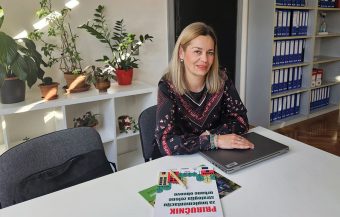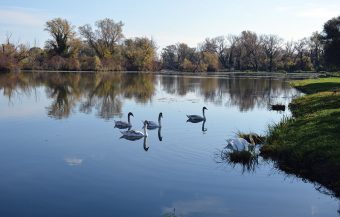
Green spaces in urban areas significantly raise the quality of life in a society undergoing intense urbanization. Constant improvement of green infrastructure contributes to sustainable development and, at the same time, has social, environmental, and economic benefits. In Croatia, one of Serbia’s neighbors, implementing green infrastructure is becoming increasingly common while applying green principles has generated recognizable benefits, which have led to significant investments in this area.
After the Government of the Republic of Croatia adopted the Program for the Development of Green Infrastructure in Urban Areas, which covers the period until 2030, in December 2021, the Ministry of Physical Planning, Construction and State Assets launched two calls for grants – one for the development of green urban renewal strategies and the other for the implementation of a pilot project, to which almost 25 million euros have been allocated to through the 2021-2026 National Recovery and Resilience Plan. We spoke with Ines Androić Brajčić, Head of Sector for Green Urban Infrastructure and Circular Management of Spaces and Buildings in the Ministry of Physical Planning, Construction and State Assets of the Republic of Croatia, about the green construction standards in architectural practice, the development of green infrastructure in urban areas, EU funds, as well as the Green Urban Renewal Strategy.
In focus:
- BIG SOLAR USES AN ENVIRONMENTALLY FRIENDLY METHOD TO CLEAN AND MAINTAIN SOLAR PANELS
- SOCIAL NETWORKS FROM A DIFFERENT ECO-ANGLE
- MT-KOMEX BH – REGIONAL ACTOR FOR SOLAR ENERGY
Q: What is the way to greener cities and municipalities in Croatia?
A: The way to greener cities and municipalities is the development of the Green Urban Renewal Strategy, an important strategic basis for local governments. The strategy refers to accomplishing green infrastructure development goals, integrating nature-based solutions, improving circular management of space and buildings, meeting energy efficiency goals, adapting to climate change and boosting resistance to risks. Ninety-six cities and municipalities applied following our public call to develop Green Urban Renewal Strategies, which clearly shows that the importance of green urban renewal has been recognized. In addition to providing implementation policies and co-financing from the EU and national sources, the Ministry also supports the development of various guidelines and methodologies and holds training sessions and the like.
Q: How do you define green infrastructure, and what are its benefits? There would be no green construction without green architectural projects. How long have green building standards been used in architectural practice, and what do they most often imply?
A: The Spatial Planning Act defines green infrastructure as planned green and water areas and other nature-based spatial solutions which are applied in cities and municipalities, and which contribute to the preservation, improvement and restoration of nature, natural functions and processes as well as generate environmental, economic, and social benefits. The benefits of green infrastructure are multiple and vary from environmental to economic and diverse social benefits. Environmental benefits are, for example, the reduction of pollution and greenhouse gas emissions or the mitigation of the thermal island effect, achieved by reducing the air temperature in cities. Economic benefits include a reduction in overall energy demand, indirect damage reduction from extreme rainfall and flooding, higher value of real estate and others. Social benefits include improving the quality of life and health of people living in cities, creating a pleasant living environment, connecting different social groups and encouraging their interaction and contributing to the preservation of architectural heritage and the vision of cities by renovating parks and gardens, as well as amassing new heritage by creating new spaces. These are just some of the many benefits of green infrastructure. The Ministry also encourages the energy renovation of public and multi-apartment buildings and family houses and the implementation of green infrastructure elements in those buildings, such as green roofs and building fronts. We encourage integral renovation, which includes at least one energy renovation measure, with a minimum energy saving of 50 per cent.
Furthermore, we support the in-depth renovation defined by the Construction Law, which implies a reduction of energy consumption for heating and primary energy by 50 per cent annually and a complete renovation prescribed by the Directive on the energy properties of buildings from 2018, which additionally includes increasing seismic resistance, fire protection and improvement of indoor climate conditions in buildings. None of that is implemented without special consideration for Program. This Program was created to establish sustainable, resilient, safe, pleasant, and orderly cities and municipalities in Croatia, i.e. its goal is to create prerequisites for a better quality of life and health of people and contribute to sustainable social, economic and spatial development. This will be achieved by quality planning and management of the development of green infrastructure and its improvement, as well as by ensuring its availability and boosting knowledge and social awareness of sustainable development.

Q: How much money did Croatia receive from EU funds and green infrastructure development programs, how were they used, and how many countries encourage this important segment?
A: Through EU funds for the development of green infrastructure, local governments have several sources of funding at their disposal. One funding source for local governments is the 2021-2026 National Recovery and Resilience Plan from the NextGenerationEU and REPoverEU mechanisms, with 25 million euros at local governments’ disposal. This money is for the development of the Green Urban Renewal Strategy and the implementation of pilot projects. Also, the 2021-2027 Operational Competitiveness and Cohesion Program has envisaged 71 million euros for green infrastructure development projects in urban areas that will come from the European Regional Development Fund. Costs related to investments in green infrastructure are also justifiable costs as part of the 2021- 2027 Integrated Territorial Program. The Republic of Croatia also provides national funding, awarded through tenders launched by the Environmental Protection and Energy Efficiency Fund. spaces and canopy coverage. Each Member State must draw up its nature restoration plan based on the draft Law. Currently, the European Commission is preparing guidelines for developing those plans, and when they are completed, more will be known about the Law’s implementation.
Interviewed by Mirjana Vujadinović Tomevski
Read the story in the new issue of the Energy portal Magazine SUSTAINABLE ARCHITECTURE AND FINANCING OF GREEN CONSTRUCTION



